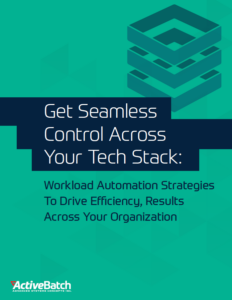Process Orchestration Is Taking Automation To The Next Level
Process orchestration tools enable IT to develop, manage, and monitor end-to-end processes from a single location. See how this is changing automation.

IT is getting more complicated, quickly.
When speaking about the challenges of the COVID crisis, Microsoft CEO Satya Nadella stated that, “We’ve seen two years’ worth of digital transformation in two months.”
There’s a lot of data to back that up:
- CIOreview.com reports that digital transformation (DX) spending will double by 2023
- 60% of IT leaders will implement disruptive tech to drive innovation by 2025 (up from 5% in 2019), according to Garter
- IDC.com found that 30% of businesses will accelerate initiatives to reinvent their business models in 2021, in order to “future proof their businesses”
Organizations have spent the past year adapting to a slew of new normals: social distancing, remote work, virtual services, and more. Most of these changes have relied on IT teams that were already busy managing complex environments and resource gaps.
Social distancing and lockdowns will eventually end, but the COVID crisis has already changed how organizations view DX. It’s no longer just about efficiency and productivity, but resiliency —that long sought-after goal of being able to quickly adapt to new challenges.
What is Process Orchestration?
Process orchestration brings together all your business and IT processes in one centralized automation platform. This approach is used in workload automation where IT teams create automated end-to-end processes. By concentrating all your processes in one place, organizations can better manage, monitor and optimize their processes.
Process orchestration gives IT leaders the visibility and control they’re lacking. With a centralized platform, it’s easy to implement standardized processes, identify and remediate issues and ensure that no resources are spent running multiple schedulers or automation platforms.
Process Orchestration vs. Process Automation
Businesses and IT organizations have been talking about automation for decades, and the benefits of automation are fairly well understood. By automating manual processes, organizations can:
- Reduce human error, which increases reliability
- Remove the need for human intervention, which can make processes more efficient
- Increase productivity by helping employees achieve more in less time
- Boost morale by removing tedious, repetitive tasks
- And more
Traditionally, automation has been achieved on an opportunistic basis. For instance, a job scheduler might be used to manage overnight batch processes, while a separate tool is used to gather customer data, and a collection of custom scripts is used to move that data between environments.
Process orchestration, on the other hand, refers to the practice of unifying those individual tasks into end-to-end processes, often by using an extensible automation tool. This allows IT teams to manage the entire process lifecycle from a single location, including development, testing, monitoring, and managing.
Process orchestration has several key benefits over traditional automation practices. This includes:
- Reducing complexity by coordinating and consolidating disparate tools
- Increasing resiliency by reducing the need for custom scripts
- Improving mean time to resolution (MTTR) by centralizing the monitoring and logging of processes
- Simplifying compliance by managing audit and credential requirements from a single location
- Integrating new tools and technologies with a single orchestration platform instead of multiple, siloed applications
Simple Task Automation Is No Longer Enough
In a recent paper from 2020, Gartner analysts explained how many of its clients report having “at least eight tools” being used for automation that are “deployed and utilized in silos.”
One of the main drawbacks to a siloed automation strategy is that integrating new tools becomes a small nightmare. If the business wants to roll-out a new online service, the IT team has to deploy a new platform and then integrate that platform with multiple, disparate tools across siloed environments.
In fact, a research paper published by MuleSoft showed that, in 2020, large businesses had on average 900 applications, only 28% of which were integrated. The paper went on to explain that a whopping 85% of IT organizations report that “integration challenges are slowing digital transformation.”
In order to rapidly adapt to new challenges —whether economic, regulatory, technological, or consumer-driven— IT teams must be able to quickly integrate new tools, platforms, and technologies.
IT’s traditional approach to automation, which is opportunistic and often applied in silos, worked well when change was slow and environments were relatively homogeneous. Today however, those environments can span on-premises and cloud-based systems, incorporating a variety of tools from multiple different vendors.
And of course, the pace of change has accelerated. It no longer makes sense for IT teams to spend time writing, testing, and editing custom scripts to move data between IT systems.
Don’t Settle For Unreliable Automation
Improve reliability and extensibility across your environment with the right workload automation strategies and tools.
How Orchestration Tools Differ From Automation Tools
Traditional automation solutions enable IT to automate discrete tasks. Common examples are native job schedulers, robotic process automation (RPA) tools, custom scripting, and business process management (BPM) tools. Automated tasks can be scheduled, ad hoc, or triggered by related IT or business events.
Process orchestration tools offer the same capabilities —many are in fact automation tools— but with several major differences.
First, process orchestration tools are designed to be extensible, streamlining system integrations by providing universal connectors, direct integrations, or API adapters. This is a far cry from traditional automation tools that are designed to support specific vendors such as Microsoft, Oracle, or SAP systems.
Process orchestration tools make it possible to rapidly integrate virtually any tool or technology.
Data and dependencies from those new tools can then be seamlessly incorporated into existing end-to-end processes using low-code, drag-and-drop workflow designers. These disparate processes, including the resources and applications they depend on, can then be monitored and maintained through the process orchestration platform.
What To Look For In A Process Orchestration Platform
“…we predict a renaissance of the existing market offerings —a shift from task-centric to more process-level automation and eventually to process orchestration.”
– Gartner, Hype Cycle for Business Process Services
Process orchestration is a relatively new field. As such, there aren’t many market offerings branding themselves as orchestration engines. Most of what is available are automation tools that have differentiated themselves by making it possible to manage disparate processes from a single location.
So what should you look for in a process orchestration platform? Here’s a decent place to start:
- REST API adapters
Most platforms and applications provide REST APIs. A process orchestration tool with a REST API adapter makes it possible to turn those API methods into reusable, automated tasks that can be quickly added into end-to-end processes. - Real-Time Monitoring
Real-time monitoring can drastically reduce the time spent troubleshooting while making it easier to optimize existing processes. Real-time monitoring can be used to support auto-remediation processes and, when artificial intelligence is incorporated, can provide intelligent automation that further reduces runtimes, prevents delays, and improves SLAs. - Self-Service Portals
The goal of process orchestration is to centralize and streamline automated processes. This includes IT processes, business processes, and help desks. Self-service portals give non-IT users the ability to run, cancel, and restart their own automated processes via an easy-to-use user interface, while keeping IT in control. This reduces the volume of support tickets IT has to manage, leaving more time for development. - Low-Code Development
Process orchestration tools can provide a variety of DevOps tools that include dependency mapping, process modeling, and collaboration tools. Most important among these capabilities is low-code development. This is usually supported by a drag-and-drop workflow designer that abstracts away the underlying code, making it easy for developers to assemble end-to-end processes without extensive knowledge of the underlying code.
The Future Of Process Orchestration
Gartner expects that, by 2025, 80% of organizations using traditional automation tools will switch to platforms that support process orchestration. Much of this demand is driven by the proliferation of cloud-based applications and resources. Organizations are increasingly reliant on cloud providers, and not just one —a majority of organizations are using multiple cloud vendors.
Traditional automation tools are unable to keep pace with the growing diversity of tools IT and business teams rely on. As a result, IT teams will continue to migrate to extensible automation platforms that make it possible to develop, monitor, and manage multiple automation environments from a single pane of glass.
Frequently Asked Questions
Automation is the process by which individual steps are connected and run automatically using a software tool or platform. Orchestration brings together different processes in a centralized platform where they can be easily monitored and managed.
Process orchestration refers to the approach where an organization brings its processes into one centralized platform, where they can be easily managed and monitored. Workflows, like processes, are a series of actions that can cross multiple applications, servers or tools. Process orchestration can be used on workflows, processes and workloads to bring visibility and control over an organization’s automations.
Process orchestration plays an important role in an organization’s maturation process. After implementing automation and seeing its benefits, organizations will need to mature their operations to continue reaping increased efficiency, improved visibility and better control. By adding process orchestration, organizations will be able to standardize processes, reduce complexity and increase resiliency.
Orchestration can be implemented in varying environments, from a specific project up to all the processes in the entire organization. Some IT leaders may decide to introduce orchestration with a specific project as a way to test the new approach and tools. Orchestration in a project is a good way to deliver results faster and create buy-in for a larger rollout.
Ready to simplify your data warehousing with workload automation?
Schedule a demo to watch our experts run jobs that match your business requirements in ActiveBatch. Get your questions answered and learn how easy it is to build and maintain your jobs.








